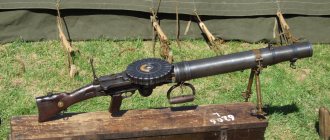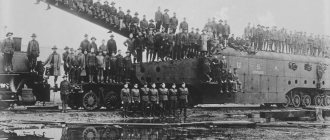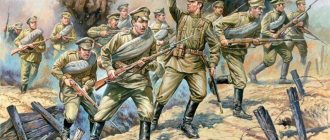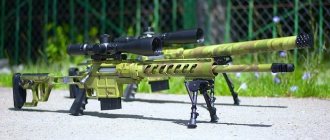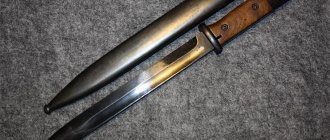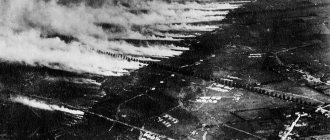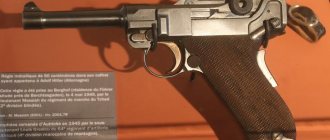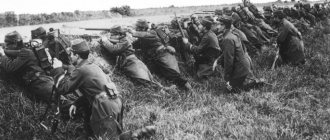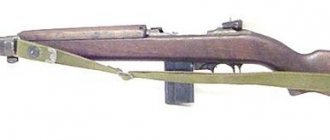Lever Action Rifle Type
| Model 1895 | |
| Type | Lever Action Rifle |
| Place of origin | United States |
| Service history | |
| In service | 1895–1945 |
| Used | Russian Empire Estonia Finland Spanish Republic Nazi Germany Mexico United Kingdom United States |
| Wars | Spanish-American War Philippine-American War Russo-Japanese War Mexican Revolution World War I Finnish Civil War Russian Civil War Polish-Soviet War Spanish Civil War World War II |
| Production history | |
| Designer | John Browning |
| Designed by | 1895 |
| Manufacturer | Winchester Repeating Arms Company Browning Arms Company |
| Produced | 1895–1940 (original; special order 1936-40) 1984 (Browning; limited edition) 1995–present (Winchester; limited editions) |
| No. built | About 425,000 |
| Options | Rifle, Carbine |
| Characteristics | |
| Weight | 4.2 kg (9.3 lb) [1] |
| Length | 1175 mm (46.3 in) [1] |
| Barrel length | 710 mm (28 in) [1] |
| Cartridge | .30-40 Krag 7.62 × 54 mm R 7.92 × 57 mm .303 British .30-30 .30-06 Springfield .35 WCF .38-72 WCF .40-72 WCF .405 Winchester |
| Action | Lever action |
| Feeding system | Internal magazine for 5.4 rounds |
| Attractions | Rear: Sliding ramp Front: Fixed post |
Winchester Model 1895 advertisement.
Winchester Model 1895
is an American lever-action repeating firearm designed and manufactured by the Winchester Repeating Arms Company in the late 19th century, chambered for a range of full-size military and hunting cartridges such as 7.62×54mmR, .303 British, . 30-03, .30 Army, .30-06, .35 Winchester, .38-72 Winchester, .40-72 Winchester and .405 Winchester.
Design[edit]
The first Model 1895 was the first Winchester rifle to feature a box magazine located under the bolt, instead of a tubular magazine, which was fundamentally unchanged from the Winchester 1866. This allowed the carbine to safely load combat and hunting cartridges with Spitzer (pointed) bullets. The M1895 was also the last lever-action rifle designed by John Browning, and featured a rear locking bolt, similar to his previous designs dating back to the 1886 Winchester. The M1895 is the most powerful lever-action rifle produced by Winchester, designed to withstand the increased pressure created by the more powerful smokeless powder cartridges in general use at the time of its release. However, by today's standards the design is considered relatively weak and not suitable for high pressure loads. [2]
Around serial number 5000, a new receiver profile was introduced with fluted (scalloped) sides, as opposed to the original flat-sided design. This new receiver reduced the weight of the rifle slightly and increased the width by 1/16 inch. Serial number 6000 is believed to be the last of the flat-sided M1895s to leave the factory. These early rifles are now extremely rare. [3] [ link required
]
Who was Benjamin Henry
In 1860, the talented inventor B. Henry joined the company and improved the Winchester carbine. The weapon, which now included a tubular-type under-barrel magazine, required a special rimfire cartridge. This ammunition was branded with the Latin letter “H” (the initial Henry) on the bottom of the case and was also produced by the company, bringing in considerable income.
The Henry rifle also received another unit that made it easier to fire: the bolt was controlled by a lever, it could be cocked without removing the butt from the shoulder, which reduced the time to bring the weapon into combat readiness and increased the rate of fire. Not only during hunting, but also during unwanted encounters with robbers or Indian tribes, this quality could play a decisive role in preserving the life of the shooter.
Military[edit]
Between 1915 and 1917, approximately 294,000 M1895 rifles were manufactured for the air force and police units of the Russian Empire, representing about 70% of total rifle production until 1932, when production of the M1895 ceased. Chambered in 7.62×54mmR, these versions were unusual for a lever-action rifle in that they also had a manual charger, allowing the M1895 rifle to be reloaded with the same charger clips used in the Mosin–Nagant bolt-action rifles. [4] Rifles made under the Russian contract had a longer barrel than standard, with an extended forward lever and a bayonet lug. [5]The initial delivery of the rifles was delayed because adaptation to Russian standards, especially the charger manual, proved more difficult than expected. [6] Additional delays were caused by the incompetent and obstructive actions of Russian inspectors, who refused to use Winchester-made measuring instruments despite the lack of Russian measuring instruments, [6] insisted on sending test ammunition from Russia (instead of using existing Winchester-made ammunition Russia. contract), [7] and often rejected rifles due to minor flaws, such as the grain of the wood in the stock, which was not straight enough. [7] Winchester later sold these rejected rifles to the US commercial market. [7] Russia issued many of its Winchester Model 1895 rifles to troops from Finland and the Baltic states, especially Latvian riflemen. [8] It is known that at least 9,000 Model 1895 rifles were provided by the Soviet Union in 1936 to the Spanish Republicans for use in the Spanish Civil War. [9]
Other countries adopted the rifle in more limited quantities. The United States ordered 10,000 .30/40 Krags for the Spanish–American War, but the war ended before they arrived at the front. [5] These rifles were marked "US" on the top of the receiver ring and were fitted with a stock similar to the M1895 Lee Navy, including a short 8 5 ⁄ 16 in (21.1 cm) knife-type bayonet. Many of the parts were marked "KSM" by Weapons Inspector Kelly S. Morse. One hundred of these rifles were issued to the 33rd Volunteer Infantry Regiment for field testing during the Philippine–American War. The test report completed on 25 December 1899 stated that Krag–Jørgensen was significantly superior in military service. The remaining 9,900 rifles were sold to M. Harley, and most were shipped to Cuba in 1906. [10] Some of these rifles found their way to Mexico, where they were supported by Pancho Villa's troops during the Mexican Revolution. [3]
Theodore Roosevelt also personally purchased a Winchester M1895 in .30 Army caliber (.30-40 Krag) during the same time period. The Model 1895 in .30 Army also competed for the 1896 New York National Guard rifle contract, but finished second to the Savage Model 1895 [11] due to the Winchester rifle's lack of a magazine compartment and magazine counter . [12] Winchester strongly disputed the results of the competition, claiming that the competition was rigged in Savage's favor, and the ensuing political disagreements led to the termination of the contract. [13]
Chukotka smuggling
The legendary weapons of the pioneers of the West and gold miners of Alaska were enjoyed by the inhabitants of the Russian Far North. Historical science is silent about how Winchester brand shotguns and carbines ended up on the territory of the USSR during the years when the border was firmly locked. Obviously, the born hunters of Chukotka knew how to penetrate the American continent better than their numerous bosses; at least, the very presence of repeating rifles with the “Made in the USA” stamp indirectly confirms the smuggling version. In the Far Eastern regions of the Russian Federation, even today you can see hard drives of different years of production and modifications among the local population. It is impossible to confuse purely American models with the samples supplied during the First World War. Officially imported rifles were equipped with a bayonet mount and had other design features.
Civil [edit]
As with previous Winchester rifles, a new range of serial numbers was introduced with the M1895, starting with serial number 1. [14] Including military contract rifles, a total of 425,881 rifles were produced, which were discontinued with serial number 425,132 Standard barrel length varied from 24 to 28 inches, depending on chambering and configuration, and the standard finish on all rifles was blue. [3]
Today, the rifle is most often associated with former President Theodore Roosevelt; however, it was also used by many other famous hunters and adventurers, including Martin and Osa Johnson, Charles Cottar and the writer Stuart Edward White. [2] Garritt Forbes - hunting companion of W.D.M. Bella, cousin of Franklin D. Roosevelt and longtime personal friend of gunsmith writer and firearms enthusiast Elmer Keith, recommended the M1895 rifle in .405 Winchester to Theodore Roosevelt. [15]
Theodore Roosevelt took two M1895 rifles with him on his 1909 safari to East Africa, both chambered in .405 Winchester. Additionally, Kermit Roosevelt accompanied his father on the trip and brought two more M1895 rifles; one was chambered in .405 Winchester and the other was chambered in .30-03 Springfield. Although the serial number of the .30-03 Kermit was lost, the serial numbers of the three .405 rifles known to be 63727, 63736 and 68180. [16] Theodore Roosevelt praised the .405 M1895 in his book African Game Trails
, famously called this rifle his "medicine gun" for lions:
But while we stood, one of the porters behind shouted, "Simba";
and we caught a glimpse of a large lioness galloping close to the trees, just beyond the donga... Tarleton took his large double trunk, and advised me to take mine, as the sun had just set, and it would probably be a close job; but I shook my head because the Winchester .405, at least for me personally, is the “medicine gun” for lions. [17]
Although it is often said that Roosevelt called the .405 M1895 his "big medicine", this phrase is never used in African Game Trails
and is possibly an erroneous combination of his "medicine gun" quote with his 1901 "big stick" speech. .
Kenneth Anderson, author and hunter, used his .405 Winchester during his shooting expeditions.
The Model 1895 in both rifle and carbine configurations was popular with the Texas Rangers and Arizona Rangers in .30-40 Krag and .30-06 Springfield calibers.
In 1985, Browning Arms reintroduced the M1895 rifle in .30-06 Springfield. [18] Later in 2001, Winchester reintroduced the rifle during the 100th anniversary of Theodore Roosevelt's presidential administration, offering it again in .405 Winchester, as well as .30-06 Springfield and .30-40 Krag since its reintroduction introduction. [2] In 2008, Winchester produced a pair of Theodore Roosevelt commemorative rifles. [19] In 2009, an additional pair of rifles was offered to commemorate Roosevelt's 1909 African safari after leaving office. [20]
Browning rifles and the new Winchester rifles are manufactured by Miroku in Japan. Winchesters, however, differ from the original design in that they are equipped with jackhammers and a fuse. Their triggers are also shaped differently and do not fit the original rifle.
Expensiveness and quality
Indeed, in the modern understanding, the manufacturing technology can be called not just outdated, but barbaric. Milling and a huge number of manual operations, material consumption and careful fitting - all these stages of the production cycle would lead today's metalworker to complete despondency. However, it was precisely thanks to such careful execution that the Winchester weapon became famous. Photos of surviving examples show not only perfectly polished surfaces, but also filigree engraving, giving the carbines a sophisticated look (at least in the cowboy or hunting sense of the word). An excellent selection of steel grades guaranteed a long service life, subject to proper care.
Links[edit]
Notes[edit]
- ^ abc Kennblätter fremdes Geräts: Heft 1: Handwaffen. item 240
- ^ abc Boddington 2005
- ^ a b c Madis 1985, pp. 450-81
- Mercaldo, Firestone and Vanderlinden 2011, pp. 77-78
- ^ ab James, Harry "Winchester Model 1895 Russian Musket" American Rifleman
April 2013 p.112 - ^ ab Mercaldo, Firestone and Vanderlinden 2011, page 79
- ^ abc Mercaldo, Firestone & Vanderlinden 2011, p. 80
- Mercaldo, Firestone and Vanderlinden 2011, p. 81
- Mercaldo, Firestone and Vanderlinden 2011, p. 83
- ↑
Canfield, Bruce N.
19th Century Military Winchesters,
March 2001
American Rifleman,
pp. 41 and 77 - Mercaldo, Firestone and Vanderlinden 2011, pp. 72-73, 190-193
- Mercaldo, Firestone and Vanderlinden 2011, p. 73
- Mercaldo, Firestone and Vanderlinden 2011, pp. 74, 193-194
- Wilson, R.L. "Model 1895 Lever Action." Winchester: An American Legend: The Official History of Winchester Firearms and Ammunition from 1849 to the Present
. New York: Random House, 1992. 104–09. Print. - Jump up
↑ Keith, Elmer M. "Elephant & Cape Buffalo Rifles."
Guns & Ammo,
April 1976 - ↑
Wilson, Robert Lawrence and Theodore Roosevelt.
"Theodore Roosevelt and the Winchester Arms Company." Theodore Roosevelt, tourist
. Agoura, CA: Trophy Room, 1994. 239–72. Print. - Roosevelt, Theodore. "Journey through thirst to Sotik." African Game Trails
. New York: Charles Schribner's Sons, 1910. 166–67. Print. - "What is the historical timeline for Browning?" Browning North America Official Website - Firearms - Rifles - Top & Bottom Shotguns - Pistols. Internet. February 15, 2011 "Archive copy". Archived from the original on February 25, 2011. Retrieved 16 February 2011.CS1 maint: archived copy as title (link).
- "Archival copy". Archived from the original on October 14, 2009. Retrieved October 2, 2009.CS1 maint: archived copy as title (link)
- "Archival copy". Archived from the original on September 13, 2009. Retrieved October 2, 2009.CS1 maint: archived copy as title (link)
- "FINNISH ARMY 1918 - 1945: RIFLES PART 5". www.jaegerplatoon.net
. Archived from the original on October 18, 2022. Retrieved April 26, 2018. - "spanishcivilwar1" . Archived from the original on October 6, 2014. Retrieved October 15, 2014.
- Jump up
↑ Weaver & Stevens 2005, p. 65 harvnb error: no target: CITEREFWeaverStevens2005 (help)
Sources [edit]
- Boddington, Craig (2005). "Bully For The .405 - Roosevelt's 'big medicine' is reborn". Weapons and ammunition. Archived from the original on March 24, 2012. Retrieved October 25, 2022.
- Madis, George (1985). The Winchester Book
. Brownsboro, TX: Art and Reference House. - Mercaldo, Luke; Firestone, Adam; Vanderlinden, Anthony (2011). Allied Shooting Contracts in America
. Wet Dog Publications. ISBN 0-9707997-7-2. - Weaver, W. Darrin; Stevens, R. Blake (2005). Desperate Measures: The Last Weapon of the Nazi Volkssturm
. Collection level publications. ISBN 0889353727.
Origin of the brand
Oliver Fisher Winchester was born in Boston in 1810. The weapon named after him became one of the symbols of America, but in 1857, when he founded, nothing foreshadowed future success. The company produced good rifles, no different from others except for the presence of a magazine that increased the rate of fire. The presence of firearms in every American home has been and remains commonplace, the right to do so is guaranteed by the US Constitution. In those days (and in a sense today too) it could perform a double task. They hunt with a gun, and they also use it to protect their home from thieves and robbers.
Weapons of hunters and cowboys
During the years of exploration of the endless prairies, settlers had in their hands revolvers and shotguns of various systems, produced by many companies, and not only American ones. It so happened that the characteristic appearance of the carbine delighted film directors, and through their efforts it became the most famous element of the “cowboy” image, with the exception, of course, of the Colt revolver, which “made people equal.” However, it should be remembered that both the 1860 and 1873 models, and the models of subsequent years, are not combat weapons, but primarily hunting weapons. Winchester, however, turned out to be so convenient that it attracted the interest of the military, and not only in the United States.


